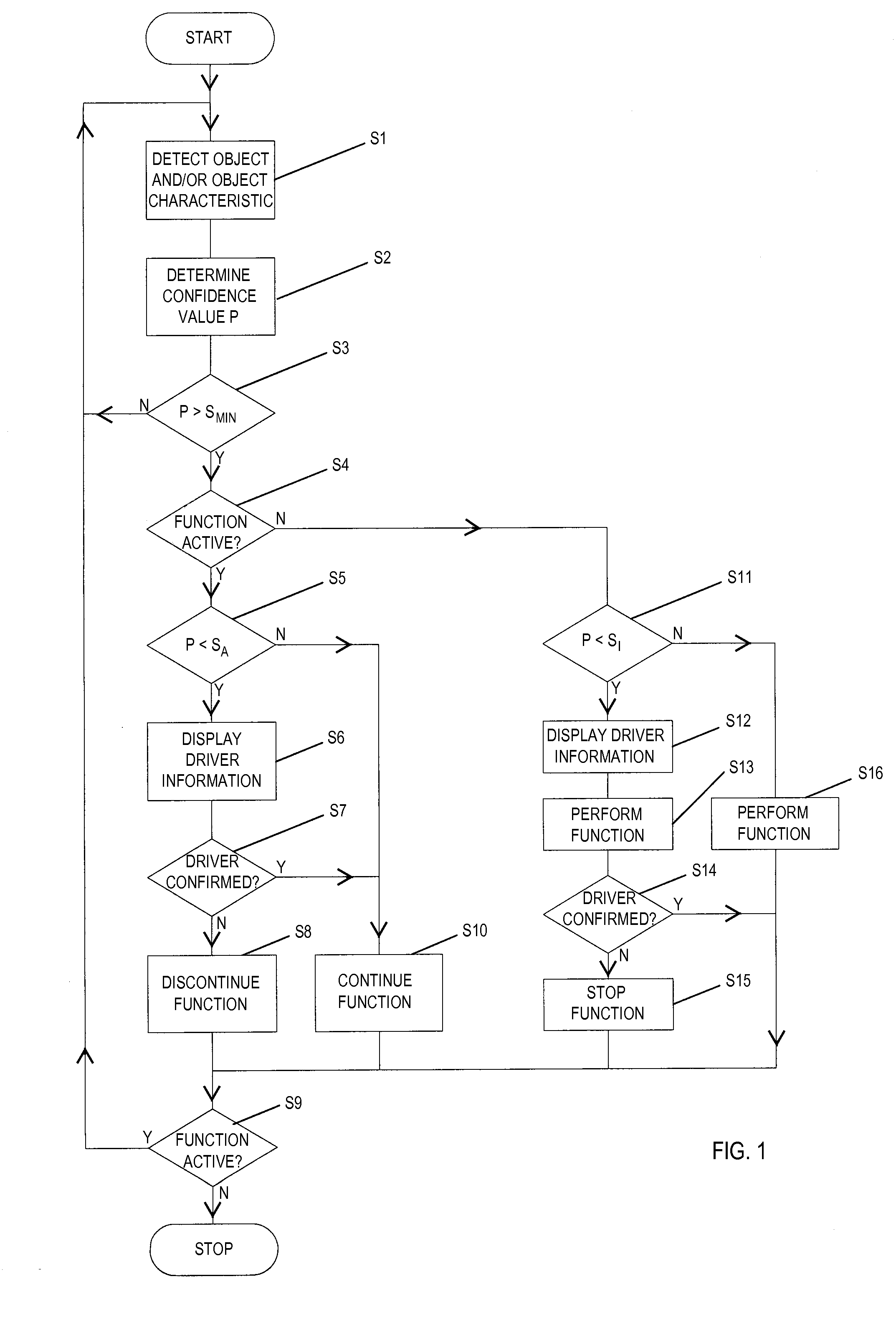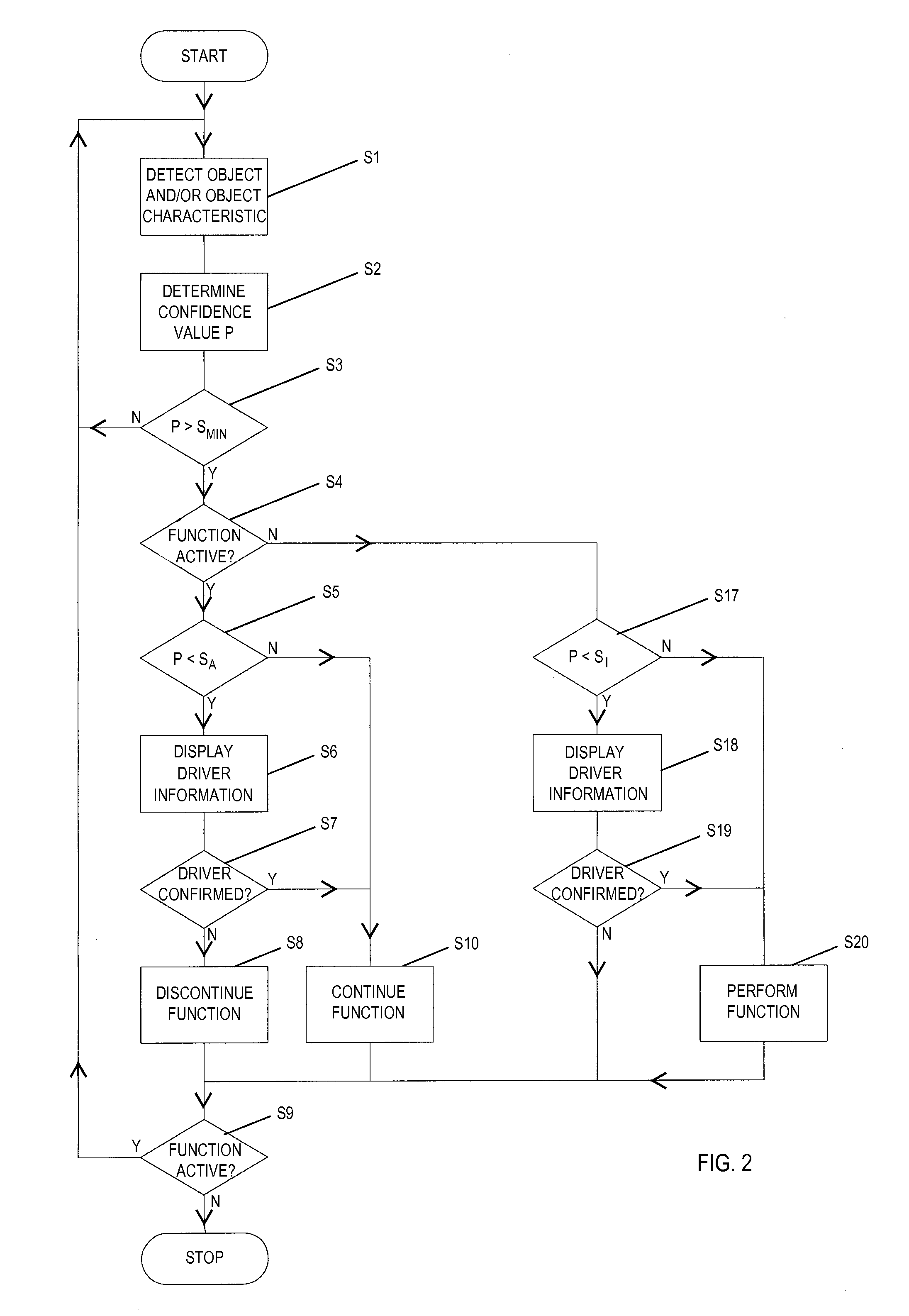Method of Operating a Driver Assistance System of a Motor Vehicle
a technology of driver assistance and motor vehicles, which is applied in the direction of steering initiation, instruments, vessel construction, etc., can solve the problems of increasing the affecting and the relative small occurrence rate of erroneous reactions of the system, so as to improve the comfort of the driver and facilitate the interaction of the driver. the effect of the interaction
- Summary
- Abstract
- Description
- Claims
- Application Information
AI Technical Summary
Benefits of technology
Problems solved by technology
Method used
Image
Examples
first example embodiment
[0030]A vehicle, for example a motor vehicle, is equipped with an Adaptive Cruise Control (ACC) driver assistance system, which includes one or more surroundings sensors, for example such as a radar sensor, and a processing circuit comprising an object recognition arrangement or object recognition circuit including an image processor, a further data processor or other electronic circuit elements (e.g. comparators) for evaluating data received from the one or more surroundings sensors, a data storage memory, and other elements conventionally included in a driver assistance system. The surroundings sensors may be any types of sensors, e.g. radar sensors and / or video cameras, used in ACC systems. The object recognition arrangement or unit may be any such arrangement used for object recognition in any known ACC system. The at least one surroundings sensor detects objects in the surroundings of the subject motor vehicle, for example objects on the roadway and especially in the traffic la...
second example embodiment
[0042]A second example embodiment of an inventive method corresponds to the first example embodiment in that a motor vehicle is equipped with an ACC driver assistance system, which uses one or more surroundings sensors, such as a radar sensor for example, to detect objects in a detection zone or area of the sensor(s) such as objects in the traffic or driving lane of the subject vehicle, and includes an object recognition unit to evaluate sensor data provided by the sensor(s) based on the detected objects in the detection area. The ACC driver assistance system then performs a following control so that the subject vehicle follows a leading target object according to the method described above with reference to FIG. 1. In the present second example embodiment it is assumed as a starting point, that a first target object has already been detected and recognized for carrying out a following control to follow the first target object.
[0043]Then after starting the method, in a method step S...
third example embodiment
[0050]In a third example embodiment of the invention, a motor vehicle comprises a driver assistance system with a lane detection and recognition function. Such a driver assistance system can be embodied in an ACC system which can perform not only a target object following control but also a lane following control. The lane recognition can also be used for emitting a warning when the vehicle departs from its own lane (Lane Departure Warning), or for a driver assistance function to aid the driver in keeping the vehicle in its own lane (Lane Keeping Assistant), or for assisting the driver in changing lanes (Lane Changing Assistant). Various such assistant systems and the components necessary for carrying out such assistance functions are known, and can be suitably incorporated in a system for carrying out the method as disclosed herein.
[0051]For detecting and recognizing a traffic lane on the roadway, such a driver assistance system includes one or more surroundings sensors, for exampl...
PUM
 Login to View More
Login to View More Abstract
Description
Claims
Application Information
 Login to View More
Login to View More - R&D
- Intellectual Property
- Life Sciences
- Materials
- Tech Scout
- Unparalleled Data Quality
- Higher Quality Content
- 60% Fewer Hallucinations
Browse by: Latest US Patents, China's latest patents, Technical Efficacy Thesaurus, Application Domain, Technology Topic, Popular Technical Reports.
© 2025 PatSnap. All rights reserved.Legal|Privacy policy|Modern Slavery Act Transparency Statement|Sitemap|About US| Contact US: help@patsnap.com



